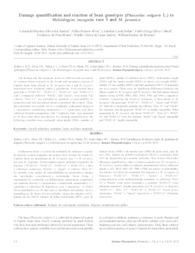Damage quantification and reaction of bean genotypes (Phaseolus vulgaris L.) to Meloidogyne incognita race 3 and M. javanica.
Damage quantification and reaction of bean genotypes (Phaseolus vulgaris L.) to Meloidogyne incognita race 3 and M. javanica.
Author(s): SANTOS, L. N. S. dos; ALVES, F. R.; BELAN, L. L.; CABRAL, P. D. S.; MATTA, F. de P.; JESUS JÚNIOR, W. C. de; MORAES, W. B. de
Summary: The damage and the resistance levels of cultivars and accessions of common beans rescued in the South and mountain regions of Espírito Santo State, Brazil, to M. incognita race 3 and M. javanica parasitism were evaluated under a greenhouse. Four rescued bean genotypes ("FORT-10", "FORT-13", "FORT-16" and "FORT-19") and 2 commercial cultivars: "Pérola", and "Aporé", were tested. The cultivar "Rico-23" was included as standard of susceptibility to nematodes and non-inoculated plants constituted the control. Thus, the experiment was carried out in a completely randomized design in 3 (treatments considering nematodes) x 7 (genotypes and bean cultivars) factorial arrangement, with 7 replicates. Data were measured at 50 days after plant inoculation. For damage quantification, the following variables were evaluated: plant height (PHE), number of nodes (NNO), number of trifoliate leaves (NRT), fresh matter weight (FWE) and dry matter weight (DWE) of shoots, root weight (RWE), number of root nodules (NRO) and final population (FPO) of nematodes per root system. There were no significant differences between the effects caused by M. incognita and M. javanica, but both species showed inferior values of PHE, NNO, NRT, RWE, FWE and DWE compared to controls. Concerning the levels of resistance of bean plants to M. incognita, the genotypes "FORT-10", "FORT-13", "Aporé" and "FORT-16" behaved as moderately resistant, the cultivars "Rico 23" and "Pérola" low resistant, and the genotype "FORT-19" as highly susceptible. When parasitized by M. javanica, the beans "FORT-19", "Rico-23", "FORT-16" and "FORT-13" were low resistant, "Pérola" and "Aporé" susceptible and "FORT-10" highly susceptible.
Publication year: 2012
Types of publication: Journal article
Observation
Some of Embrapa's publications are published as ePub files. To read them, use or download one of the following free software options to your computer or mobile device. Android: Google Play Books; IOS: iBooks; Windows and Linux: Calibre.
Access other publications
Access the Agricultural Research Database (BDPA) to consult Embrapa's full library collection and records.
Visit Embrapa Bookstore to purchase books and other publications sold by Embrapa.

